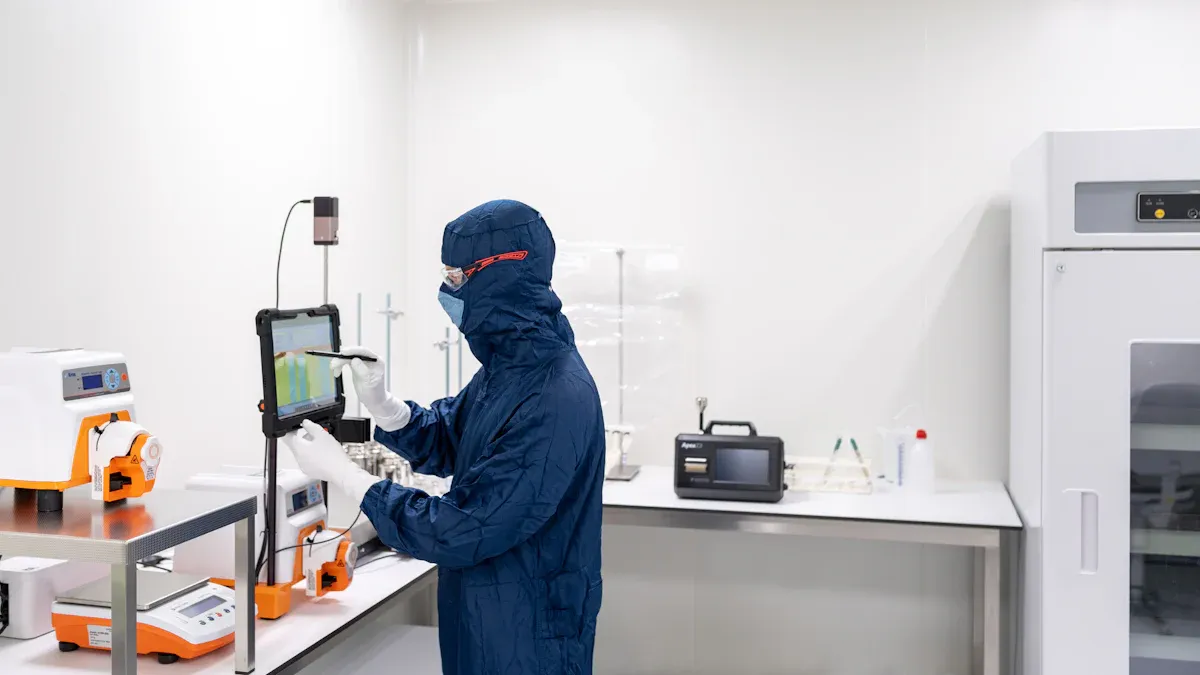
Machine learning models deliver accurate humidity prediction. They analyze complex patterns from historical sensor data and operational variables. This advanced machine learning approach transforms production humidity management. It provides a dynamic solution for controlling humidity levels.
Traditional methods rely on static setpoints and manual checks. These older systems struggle with changing conditions. They often require constant human intervention. The new approach adapts automatically, improving quality control and operational efficiency from the first sensor reading.
Building Your Predictive Machine Learning Model

A successful machine learning model begins with a strong data foundation. The process involves gathering the right information, engineering insightful features, and selecting an appropriate algorithm for training. This structured approach transforms raw data into a powerful tool for humidity management.
Essential Data Collection
Effective humidity control starts with comprehensive data collection. The model needs information from both the internal production environment and external sources. Internal data comes directly from the facility's sensor network.
A typical setup includes multiple sensor devices collecting data at high frequency. These sensors often record readings in intervals of seconds or minutes. Key internal data points include:
- Temperature
- Humidity
- Atmospheric pressure
External data provides valuable context about conditions outside the facility. Weather APIs, such as Open-Meteo, offer crucial feeds. This data helps the model anticipate changes in indoor humidity based on outdoor weather shifts. Modern weather datasets blend forecasts with historical actuals for variables like relative humidity, temperature, and wind speed. This information is also vital for energy load forecasting, which optimizes electricity demand.
Feature Engineering for Indoor Humidity
Raw sensor data alone is not enough. Feature engineering transforms this data into meaningful inputs that machine learning models can understand. This step is critical for accurately predicting indoor humidity. It reveals hidden patterns and relationships within the data.
Pro Tip: Creating time-based features allows the model to understand how humidity behaves at different times. This is a cornerstone of effective time-series forecasting.
Three powerful feature engineering techniques improve model performance:
- Slag Window Statistics: This technique calculates statistics over a defined time period. For example, a 24-hour moving average of humidity smooths out short-term fluctuations. It helps the model identify longer-term trends.
- Temporal Features: These features capture cyclical patterns. Creating features for the 'hour of the day' or 'day of the week' helps the model learn daily and weekly humidity cycles. These are essential inputs for predicting future energy use and managing the internal environment.
- Lag Features: These features provide the model with historical context. A lag feature, such as the humidity value from one hour ago, gives the model recent information. Models can use past values from related variables like temperature or humidity to predict future outcomes. This approach helps capture the underlying structure of the data.
Model Selection and Training
Choosing the right algorithm is essential for building an effective humidity control system. The selection process should focus on models that can handle complex, nonlinear relationships found in sensor data.
For this task, Random Forest is an excellent starting point. It is one of the best machine learning models for this application. It offers several advantages:
- It handles complex problems without needing statistical pre-assumptions.
- It is simple to train and implement.
- It delivers reliable predictions by averaging results from many decision trees.
Other powerful alternatives exist. Recent research shows that XGBoost, a gradient boosting algorithm, significantly improves temperature and dew point forecasts. Recurrent Neural Networks (RNNs) are also well-suited for time-series prediction tasks.
Once a model is selected, the training process begins. This involves splitting the dataset and teaching the model.
# Example of a time-based data split
# 80% of the oldest data for training, 20% of the newest data for testing
train_size = int(len(data) * 0.8)
train_data, test_data = data[:train_size], data[train_size:]
For time-series data, a chronological split is crucial. Teams must use older data for training and newer data for testing. A standard 80/20 split is common. This method prevents "data leakage," where information from the future accidentally informs the model. This ensures the model's performance reflects a real-world scenario. The model then trains on the engineered features from the training set, using an optimizer like ADAM to fine-tune its parameters for the best possible prediction accuracy. This disciplined process builds a robust humidity control system.
Implementing Your Model for Humidity Control

After training a model, the next step is to implement it in the production environment. This phase moves the model from a theoretical tool to a practical asset for humidity management. It involves two critical stages: validating the model's predictive power and integrating it into a functional system architecture.
Validating Model Performance
Validating a model's performance is essential. It confirms that the model's predictions are accurate and reliable enough for real-world use. Teams use specific statistical metrics to measure how closely the model's predictions match actual sensor readings. A robust humidity control system depends on this rigorous evaluation.
Three key metrics provide a comprehensive view of model accuracy:
- Mean Absolute Error (MAE): MAE measures the average size of the errors in a set of predictions, without considering their direction. It is calculated by taking the average of the absolute differences between the predicted humidity and the actual humidity. A lower MAE value indicates a more accurate model. For example, studies show MAE values can range from over 4.9% to under 1.6%, depending on the model and the prediction time frame.
- Root Mean Squared Error (RMSE): RMSE is another way to measure the differences between predicted and actual values. It is sensitive to large errors because it squares the differences before averaging them. This makes it useful for spotting the impact of significant prediction mistakes. RMSE is expressed in the same units as the variable being predicted (e.g., % humidity), making it easy to understand.
- R-squared (R²): This metric shows the proportion of the variance in humidity that the model can predict from the input features. R² values range from 0 to 1. A value of 1 means the model perfectly explains the data's variation, while a value of 0 means it explains none.
🎯 Success Benchmark: For most production environments, a successful model should aim for a Mean Absolute Error (MAE) below 1% humidity. This target ensures the humidity control system operates with high precision.
The table below shows how R² values can compare the performance of different machine learning models. A higher R² value indicates a better fit.
| Model | R2 Value |
|---|---|
| XGBoost | 0.744 |
| RF | 0.717 |
| SVR | 0.253 |
System Architecture and Impact
A well-defined system architecture ensures that data flows smoothly from collection to action. A typical architecture for a real-time humidity prediction system consists of three main components. This structure supports effective humidity management.
- Data Acquisition: This layer collects raw data. It includes the physical sensor network inside the facility that records internal humidity and temperature. It also pulls external data from weather APIs. Each sensor provides a constant stream of information.
- Processing Engine: This is the system's core. It is a central server that receives data from every sensor. The machine learning model runs here, processing the information, applying engineered features, and generating humidity forecasts.
- Results Dashboard: This is the user interface. It presents the model's predictions to operators on PCs or mobile devices. The dashboard displays current conditions and future humidity forecasts, allowing staff to make informed decisions about the production environment.
Implementing such a system delivers significant real-world impact. It moves operations from a reactive to a proactive model of humidity control.
The model allowed operators to proactively adjust settings, maintaining product quality by predicting internal humidity with an average deviation of only 0.8%. This shift also led to estimated energy savings of 22%–31% by optimizing heating and cooling systems.
This data-driven approach enhances operational efficiency, reduces energy costs, and ensures greater product consistency.
Advanced Techniques in Humidity Analysis
Standard models provide a strong foundation for humidity management. Advanced techniques can unlock even greater precision and automation. These methods use specialized neural networks and Internet of Things (IoT) integration to create a responsive humidity control system.
Exploring RNNs for Time-Series Prediction
Recurrent Neural Networks (RNNs) are ideal for analyzing time-series data like indoor humidity. They excel at understanding sequences and temporal dependencies. Compared to traditional models, RNNs offer several key benefits.
- They perform well with smaller datasets.
- They are suited for tasks with short-range dependencies.
- They converge faster during training.
- They have reduced computational overhead.
Specific architectures like Gated Recurrent Units (GRUs) and Long Short-Term Memory (LSTM) units are popular choices. For example, a hybrid machine learning model combining CNN, GRU, and LSTM layers can forecast changes in an environment. This includes variables like temperature and atmospheric pressure. The choice between GRU and LSTM often involves a trade-off between stability and prediction loss, as shown below.
| Model | Prediction Loss (ppm) | Stability |
|---|---|---|
| GRU | 70.8077 to 126.7029 | Lower |
| LSTM | 78.8596 to 136.0896 | Higher |
Integrating with IoT and Real-Time Systems
Integrating models with IoT devices creates a powerful, real-time humidity control solution. This architecture connects physical sensors to a central processing engine. The system uses communication protocols like MQTT to ensure reliable data transmission. A typical workflow follows these steps:
- Data Collection: IoT sensors like the DHT11 gather humidity and temperature data from the environment.
- Microcontroller Processing: An ESP32 microcontroller processes sensor output and transmits it wirelessly.
- Cloud Integration: Data is sent to a cloud platform like ThingSpeak for storage and scaling.
- Model Application: The model processes the data to forecast indoor humidity.
- User Interface: A dashboard or smartphone app displays real-time data and predictions.
Edge Deployment: Deploying models directly on edge devices like an Nvidia Jetson Nano requires careful planning. Key considerations include the model's computational complexity, memory footprint (RAM and flash), and the device's power consumption.
This integrated approach transforms humidity management from a manual task into an automated, data-driven process.
A well-designed machine learning model provides a scientific method for managing production humidity. It moves beyond manual adjustments toward data-driven control. This advanced approach transforms the entire operation.
This shift enhances production management. It achieves greater product consistency, boosts workforce efficiency, and reduces energy waste. The result is a more reliable and profitable operation.
FAQ
How much historical data is necessary to start?
A model needs sufficient data to learn patterns. Teams should collect at least several months of sensor data. A full year is ideal. This amount captures seasonal variations in temperature and humidity, leading to a more robust and accurate predictive model for the facility.
How often should teams retrain the model?
Model performance can degrade over time. Production environments change, and sensors can drift.
Teams should plan to retrain the model quarterly or semi-annually. Regular retraining ensures the model remains accurate and adapts to new operational conditions, maintaining its effectiveness for humidity control.
Can this approach predict other environmental variables?
Yes, the methodology is highly adaptable. The same machine learning principles can predict other variables like temperature, air pressure, or CO₂ levels. The key requirement is collecting high-quality sensor data for the specific variable that the team wants to forecast.
What is the biggest challenge during implementation?
Data quality presents the most significant challenge. Inaccurate or incomplete data directly harms model performance. Common issues include:
- Missing sensor readings
- Inaccurate timestamps
- Sensor calibration drift
A strong data validation process is essential for success.
See Also
Leveraging Machine Learning to Forecast Fashion Trends and Elevate Sales Performance
The Future of Textile Manufacturing: AI-Powered Predictive Maintenance by 2025
Optimizing Inventory: Data-Driven Demand Sensing for Successful Product Drop Models
Delighting Customers: Implementing Smart Machine Learning for Personalized Order Experiences
Achieving Equilibrium: Predictive Analytics Harmonizes Fashion Industry Supply and Demand